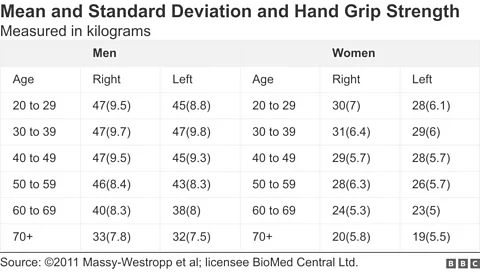Grip strength: The test for your chances of living to 100
 Getty Images
Getty ImagesGrip strength is associated with a range of health outcomes, from type 2 diabetes to depression. Here’s how to check yours.
In a world of technologically-driven longevity clinics with their increasingly sophisticated imaging scans, some of which can cost tens of thousands of dollars, it turns out that one of the best assessments of muscle strength and quality is to simply sit in a chair and squeeze a tennis ball.
That's the recommendation offered by Joshua Davidson, a strength and conditioning researcher at the University of Derby who studies hand grip strength, a metric increasingly recognised as one of the most reliable markers of human health.
When testing grip strength in clinical trials, scientists typically use a hand dynamometer, a device which you squeeze as hard as possible to measure the force generated by the muscles in your hand and forearm. Several companies are now attempting to take the dynamometer out of the clinic and into the home, combining easy-to-use devices with mobile apps to let anyone chart their grip strength over time.
However, according to Davidson, you can still get a decent idea through a simple "squeeze test" with a tennis or stress ball. "All you need is any object that you can grasp and can be deformed without causing pain or discomfort," he says. "Simply squeeze it for as long as you can before your grip fatigues. Being able to maintain a maximal squeeze on something like a tennis ball for 15-30 seconds would be a good standard to strive for." Noting down how long you can squeeze can help you track your grip strength over time.
Of course, as Mark Peterson, a physical medicine and rehabilitation professor at the University of Michigan points out, having a weak grip strength alone will have relatively little impact on your everyday life directly, beyond making it a little bit harder to open cans or jars. But researchers are increasingly using grip strength as a proxy for overall musculoskeletal strength throughout the body. It can reflect whether a person is active enough or too sedentary and indicate their risk of frailty – the condition of being vulnerable as a result of a decline in one's physiological health.
 Getty Images
Getty ImagesThis first came to scientists' attention through a particularly notable study of nearly 140,000 adults across high, middle and low-income countries which found grip strength was a better predictor for premature death than other more obvious indicators such as blood pressure.
Other research has revealed that a person's grip strength can indicate their likelihood of living past 100. In one study, volunteers had their grip strengths measured in 1965-1968, when they were between 56 and 68 years old, and their survival was tracked for the next 44 years. Those who became centenarians were 2.5 times more likely to have had grip strength results in the highest third, compared to those who died before the age of 79.
Darryl Leong, an associate professor of medicine at McMaster University in Canada, explains that your handgrip strength – and therefore your overall muscular strength – is a sum of your nutrition, physical activity and whether you have any illnesses. "This is the reason it's associated with so many health outcomes," he says.
One study which used dynamometer testing found that grip strength scores of less than 25.5 kilograms for men and 18 kilograms for women suggests a heightened risk of sarcopenia throughout the body, the progressive loss of muscle mass and function which is linked to decreased strength and mobility in later life, and a greater likelihood of falling and developing fractures.
Guillaume Paré, a practising physician and a professor of medicine at McMaster University, says that it's possible to tell a lot even from a simple handshake, with grip strength serving as a marker for whether someone is likely to have sarcopenia. "Weaker handshakes where fingers struggle to close completely around my hand, or where hand muscles are emaciated, are red flags," he says.
But the links between grip strength and longevity go well beyond physical capabilities. Studies have shown that muscle is a key player in the metabolic system, acting as a reservoir which can soak up excess blood glucose and help prevent the development of insulin resistance. Because of this, a weaker grip can indicate that a person is more prone to a plethora of problems linked to metabolic dysfunction, ranging from type 2 diabetes to lower bone mineral density, malnutrition, cognitive impairment and depression.
 ©2011 Massy-Westropp et al; licensee BioMed Central Ltd
©2011 Massy-Westropp et al; licensee BioMed Central LtdIf you do have a dynamometer to hand, you can use the chart above to compare your grip strength against. The results were taken from a study on the average grip strength measurements for healthy people in each sex across different age groups.
Back in 2022, Peterson led a study which assessed the grip strength of 1,275 men and women and compared these results to an analysis of their DNA. The team found that those with lower grip strength scores showed signs of accelerated ageing. Specifically, they had differences in their DNA methylation patterns – tags associated with our DNA which can alter the way it is read over our lifetimes. Methylation patterns often change in response to environmental or lifestyle factors, such as obesity, pollution or even social stress, among many other things.
Wrist curls: Improve your grip strength
Begin by sitting with your arms on your lap. Grip a can in your hand, with your palm facing upwards. Then slowly bring the can upwards towards your body, without moving your arm. Hold it there for a second, and carefully lower it back down. With practise, aim to build up to doing five sets of 20 repetitions.
For Paré this is unsurprising, as he says he sees grip strength as a key marker of both disease resilience and likelihood of recovering from chronic illnesses. For example, research in cancer patients shows that those with poorer grip strength are more likely to experience sudden weight loss or cachexia – extreme muscle or fat loss, despite eating normally – and thus worse prognosis and survival outcomes.
"It means that once we have a disease, our ability to fight it is limited," says Peterson. "For example, the risk of dying from a pneumonia is much increased in individuals with lower grip strength, which makes sense considering the importance of good muscular health to properly clear the airways of sputum [the saliva and mucus coughed up from the respiratory tract as a result of infections]."
Grip strength isn't just something to be aware of in later life, either. Researchers have even found that the average grip strength of a population tends to correlate with how many medals a country is likely to win at the Olympic Games. Meanwhile, Paré says that teenagers and young adults who have poorer grip strength are likely to be more prone to health issues at an earlier age. One study in Brazil showed that teenagers who spent more time on their screens, either on their phones or other devices, tended to have worse grip strength.
"There's data supporting the association of low grip strength with poor metabolic health even in young adults," says Paré.
Improving your score
So, can we improve our grip strength? Certainly, says Davidson, and it's something which you can work on irrespective of your age. He suggests simply using the tennis ball test to progressively work the muscles of your hand and forehand to contract at maximal power for as long as you can. With practise, you should see steady improvements over time, he says.
More like this:
• Sit-to-stand: The simple test that reveals how you're ageing
It also isn't just about grip. Leong recommends working on being more physically active in general and training the muscles in your lower and upper body. If you do this, he says your grip strength will improve accordingly.
For older adults, Leong suggests trying the timed get-up-and-go test. "Here, the individual records with a stopwatch, the time taken to rise from a chair, walk three metres, turn around and return to the seated position," says Leong. "This is a test of lower limb strength and mobility and will help improve your total muscle strength."
Davidson says that general resistance exercises to improve muscle mass and maintain bone mineral density will lead to improvements in grip strength. "We all need to engage in regular physical activity as we age," he says. "You can work out at home either using specialist equipment or just things you have around the house. Two to three sets of single arm wrist curls, with reps of between 10 and 20, is a good exercise to start with. If you have a kettlebell at home, bicep curls are also good exercises to try."
--
For trusted insights into better health and wellbeing rooted in science, sign up to the Health Fix newsletter, while The Essential List delivers a handpicked selection of features and insights.
